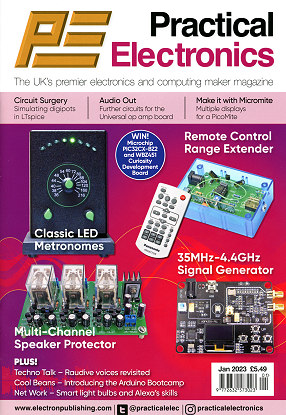January 2023
This month’s highlights
Classic LED Metronomes


We present two Metronome designs that use light-emitting diodes to simulate the classic, inverted-pendulum types. They also ‘tick’ like a real Metronome would! Two designs are offered, one with an 8-LED arc and a slightly more complex 10-LED version with relative brightness controls. Volume and brightness controls. They use classic 74HC logic chips and are built using traditional PCB techniques, making them a great project for beginners to tackle. You can enhance them using some woodworking skills.
Geekcreit’s 35MHz-4.4GHz Signal Generator


We investigate a self-contained ready-made module which utilises the Analog Devices ADF4351 wideband digital synthesiser chip. Onboard it has an MCU, a mono OLED display offering menu-driven user options and pushbuttons to set frequency and amplitude. This article will also fill in the gaps in the module’s (minimal) operating instructions.
Remote Control Range Extender


Most remote controls use infra-red LEDs to transmit commands to equipment but, as we all know, the optical signal is easily disrupted by objects, people, plants, furniture… almost anything. So this project will adapt a remote control to use UHF radio signals instead, giving it a range of up to 25 metres through weatherboard and Gyproc wall. The RC Range Extender replaces the IR Tx LED with a tiny surface-mount board fitted in the housing, and a second converter Rx unit is placed near the apparatus that receives the RF signal and drives an IR LED to command the apparatus. A PIC-micro controlled circuit with source code available from the PE online store.
![]() Surface mount devices are used and good soldering skills are required to complete construction successfully.
Surface mount devices are used and good soldering skills are required to complete construction successfully.
Multi-Channel Speaker Protector

This project will be perfect for audio fans whose setup uses lots of loudspeakers. The project safeguards against the risk of speaker damage due to eg amplifier failure outputting the DC rail to a speaker voice coil. There is also a switch-on delay included. The project could easily pay for itself the first time it activates. Built on a double-sided through-hole board using discrete components. Both 4-channel and 6-channel versions are described. An ideal accompaniment to our Hummingbird Amplifier.
Audio Out
Universal single op.amp board (Part 2)


Our in-house audio engineer introduces three more handy designs suitable for the multi-purpose op.amp board described last month. A differential amp adds balanced input to consumer audio gear, and there’s a phono and RIAA amp built on the same board too.
Also in this issue:
- Techno Talk – Raudive Voices revisited. An impartial and open-minded discourse about the possibilities of communicating electronically with those who have departed this world.
- Net Work – the latest appliance energy bands explained and Tapo smart bulbs are tested out.
- Circuit Surgery – Electronically controlled resistance (Part 5). Continuing our in-depth analysis by our in-house expert.
- Max’s Cool Beans – Arduino Bootcamp – Part 1: The first instalment of a brilliant new tutorial series that introduces the Arduino single board computer to beginners.
- Make it with Micromite – Connecting more than one display to a PicoMite.
Next month:
Driveway Gate Remote Control; Cooling Fan Controller & Loudspeaker Protector; Geekcreit’s LTDZ V5.0 Spectrum Analyser; Solid-State Flame Discharge Tesla Coil. Contents subject to change.

Printed Circuit Boards
We supply PCBs for all our projects going back to 2013.
New PE service – Programmed PICs
Buy programmed PICs for most of our projects.

